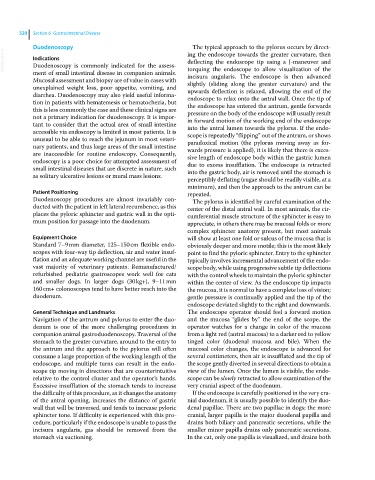Page 552 - Clinical Small Animal Internal Medicine
P. 552
520 Section 6 Gastrointestinal Disease
Duodenoscopy The typical approach to the pylorus occurs by direct-
VetBooks.ir Indications ing the endoscope towards the greater curvature, then
deflecting the endoscope tip using a J‐maneuver and
Duodenoscopy is commonly indicated for the assess-
ment of small intestinal disease in companion animals. torquing the endoscope to allow visualization of the
incisura angularis. The endoscope is then advanced
Mucosal assessment and biopsy are of value in cases with slightly (sliding along the greater curvature) and the
unexplained weight loss, poor appetite, vomiting, and upwards deflection is relaxed, allowing the end of the
diarrhea. Duodenoscopy may also yield useful informa- endoscope to relax onto the antral wall. Once the tip of
tion in patients with hematemesis or hematochezia, but the endoscope has entered the antrum, gentle forwards
this is less commonly the case and these clinical signs are pressure on the body of the endoscope will usually result
not a primary indication for duodenoscopy. It is impor- in forward motion of the working end of the endoscope
tant to consider that the actual area of small intestine into the antral lumen towards the pylorus. If the endo-
accessible via endoscopy is limited in most patients. It is scope is repeatedly “flipping” out of the antrum, or shows
unusual to be able to reach the jejunum in most veteri- paradoxical motion (the pylorus moving away as for-
nary patients, and thus large areas of the small intestine wards pressure is applied), it is likely that there is exces-
are inaccessible for routine endoscopy. Consequently, sive length of endoscope body within the gastric lumen
endoscopy is a poor choice for attempted assessment of due to excess insufflation. The endoscope is retracted
small intestinal diseases that are discrete in nature, such into the gastric body, air is removed until the stomach is
as solitary ulcerative lesions or mural mass lesions.
perceptibly deflating (rugae should be readily visible, at a
minimum), and then the approach to the antrum can be
Patient Positioning repeated.
Duodenoscopy procedures are almost invariably con- The pylorus is identified by careful examination of the
ducted with the patient in left lateral recumbence, as this center of the distal antral wall. In most animals, the cir-
places the pyloric sphincter and gastric wall in the opti- cumferential muscle structure of the sphincter is easy to
mum position for passage into the duodenum. appreciate, in others there may be mucosal folds or more
complex sphincter anatomy present, but most animals
Equipment Choice will show at least one fold or sulcus of the mucosa that is
Standard 7–9 mm diameter, 125–150 cm flexible endo- obviously deeper and more motile; this is the most likely
scopes with four‐way tip deflection, air and water insuf- point to find the pyloric sphincter. Entry to the sphincter
flation and an adequate working channel are useful in the typically involves incremental advancement of the endo-
vast majority of veterinary patients. Remanufactured/ scope body, while using progressive subtle tip deflections
refurbished pediatric gastroscopes work well for cats with the control wheels to maintain the pyloric sphincter
and smaller dogs. In larger dogs (30 kg+), 9–11 mm within the center of view. As the endoscope tip impacts
160 cm+ colonoscopes tend to have better reach into the the mucosa, it is normal to have a complete loss of vision;
duodenum. gentle pressure is continually applied and the tip of the
endoscope deviated slightly to the right and downwards.
General Technique and Landmarks The endoscope operator should feel a forward motion
Navigation of the antrum and pylorus to enter the duo- and the mucosa “glides by” the end of the scope, the
denum is one of the more challenging procedures in operator watches for a change in color of the mucosa
companion animal gastroduodenoscopy. Traversal of the from a light red (antral mucosa) to a darker red to yellow
stomach to the greater curvature, around to the entry to tinged color (duodenal mucosa and bile). When the
the antrum and the approach to the pylorus will often mucosal color changes, the endoscope is advanced for
consume a large proportion of the working length of the several centimeters, then air is insufflated and the tip of
endoscope, and multiple turns can result in the endo- the scope gently diverted in several directions to obtain a
scope tip moving in directions that are counterintuitive view of the lumen. Once the lumen is visible, the endo-
relative to the control cluster and the operator’s hands. scope can be slowly retracted to allow examination of the
Excessive insufflation of the stomach tends to increase very cranial aspect of the duodenum.
the difficulty of this procedure, as it changes the anatomy If the endoscope is carefully positioned in the very cra-
of the antral opening, increases the distance of gastric nial duodenum, it is usually possible to identify the duo-
wall that will be traversed, and tends to increase pyloric denal papillae. There are two papillae in dogs; the more
sphincter tone. If difficulty is experienced with this pro- cranial, larger papilla is the major duodenal papilla and
cedure, particularly if the endoscope is unable to pass the drains both biliary and pancreatic secretions, while the
incisura angularis, gas should be removed from the smaller minor papilla drains only pancreatic secretions.
stomach via suctioning. In the cat, only one papilla is visualized, and drains both

